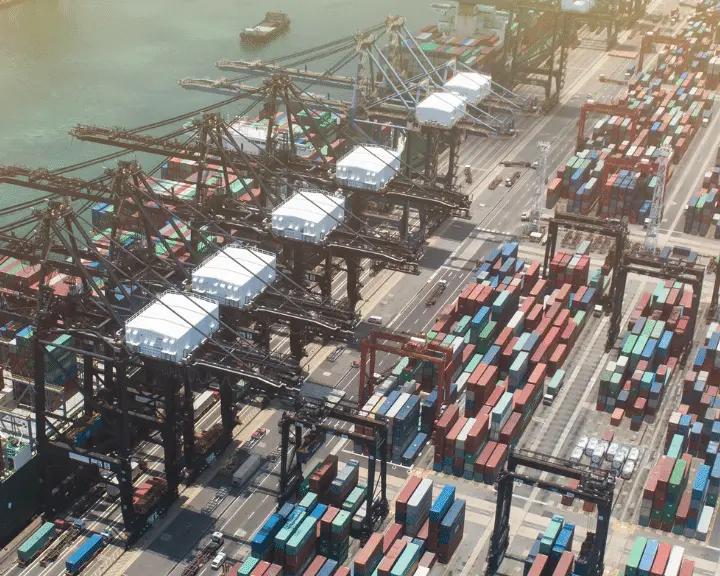Supply chain digitization prepares your company for resilient growth at any pace, and helps you seize opportunities to scale your business, whether you’re processing ten transactions a day or 10 million.
Vertical integration refers to a company controlling multiple stages of the production process or distribution process. For example, a retailer might acquire a manufacturer (backward integration), or a manufacturer might open its own stores (forward integration).
The idea behind the vertical integration strategy is simple: take ownership of more parts of the chain to gain greater control, reduce manufacturing costs, and improve coordination.
But like most strategies, vertical integration isn’t one-size-fits-all. Many shippers and logistics service providers (LSPs) chase this idea, hoping for big gains, only to find they’ve added complexity, not value.
This article will break down how vertical integration works, when it’s profitable, where it can backfire, and how alternatives like supply chain integration platforms can often deliver the same result with much less risk.
What is vertical integration in supply chains?
Vertical integration supply chains mean owning or tightly controlling more links of the supply chain process.
It can take two main forms:
- Backward integration: A company takes over its external suppliers or raw materials sources. Think of a car manufacturer buying a steel plant to control its material inputs.
- Forward integration: A company moves closer to the end customer, such as a clothing manufacturer opening its own branded retail stores to control the retail sales process.
Both types of vertical integration involve reducing dependence on third parties and managing the entire value chain internally. This is in contrast to horizontal integration, where a company expands by acquiring or merging with similar businesses (for example, one freight forwarder acquiring another). Another example is when a company acquires a critical supplier, it gains more control over materials and production timelines.
In logistics, vertical integration often occurs when shippers or LSPs try to control both upstream and downstream operations, moving beyond their core competencies. This can reshape a business's vertically integrated structure but also introduce significant challenges. Some companies pursue both horizontal and vertical integration to consolidate market share and improve supply chain resilience.
Why some companies choose vertical integration
On paper, the benefits of a vertical integration strategy look appealing, especially for large enterprises. For some, vertical integration is a long-term business strategy aimed at aligning operations across the value chain.
Here’s why companies consider it:
- Greater control over pricing, quality, timelines, and service delivery across the entire supply chain.
- Better data visibility between connected operations improves coordination.
- Lower variable production costs over time by reducing margins paid to external partners.
- Fewer third-party dependencies, reducing the risk of disruptions.
- Stronger market power by consolidating supply or distribution channels.
- Consistent customer experience, particularly when managing the full retail sales process.
- Reduces reliance on manufacturing partners to more predictable output and lower variability in quality.
When companies bring key components in-house, they can better manage quality and delivery timelines. These advantages can create a competitive edge for vertically integrated companies with enough capital. But they come at a cost.
The risks and tradeoffs to know
Vertical integration requires more than just capital. It demands a business rethink. For growing or mid-sized companies, the risks often outweigh the benefits.
Here’s why:
- High upfront investment: Acquiring or building new capabilities can drain resources.
- Reduced flexibility: When you own more of the chain, you’re tied to your own assets, making it harder to adapt quickly.
- Increased complexity: Managing diverse units pulls focus from core business strengths.
- Risk of poor fit: Acquisition considered vertical integration doesn’t guarantee success—mismatched operations can hurt performance.
- Vulnerability to market shifts: You might gain control but lose adaptability, especially in volatile logistics environments.
In some extreme cases, efforts toward full control can backfire, edging closer to a vertical monopoly that limits market adaptability and introduces antitrust concerns. Companies that overextend without proper planning risk corporate failure due to high overhead and operational inefficiencies.
As one supply chain expert said, “If you have to update your internal, home-grown systems to account for business changes, but it takes away from all business-critical activities, run. Go buy something off the shelf that does all of this.”
This tension between control and flexibility is where many companies struggle.
When vertical integration might make sense
So, how do you know if vertical integration makes sense for your business?
Here are some situations where it can be a smart move:
- Supply disruptions: If your operations are consistently at risk due to unreliable external suppliers or partners, owning key parts of the chain can stabilize the supply chain process.
- Long-term cost savings: If careful cost modeling shows that buying or building new capabilities cuts expenses over time.
- Strategic differentiation: If speed-to-market, product quality, or customer experience are central to your brand, and require control over more links in the chain.
- Operational maturity: If your company has the expertise and budget to manage a more complex, vertically integrated structure.
But this approach works best for well-capitalized players or niche businesses if careful cost modeling shows that buying or building new capabilities cuts expenses over time, making vertical integration profitable. For many others, there’s a better alternative.
Alternatives to vertical integration (that still deliver results)
Modern supply chains have another path to balance control and flexibility: supply chain integration platforms, one of several types of supply chain integration available to businesses.
Instead of owning every link, you can connect your systems and partners through tools like Chain.io to achieve similar benefits. Strategic alliances can offer flexibility without the risks that come with fully absorbing new business units.
These platforms offer:
- Real-time data flows between your business and your partners, giving you visibility without ownership
- Automation of manual tasks that would otherwise bog down operations
- Supplier collaboration without the need to acquire or fully absorb partners
For example, many shippers outsource all integration and data activities to their partners. But as our experts warn, this leaves them vulnerable if they need to change suppliers or carriers quickly.
Instead, you retain control by creating a centralized integration layer (owning at least your key partner connections) without overextending into vertical integration. In some cases, joint ventures offer a middle ground by allowing shared control of resources without full acquisition.
Tools like Chain.io specialize in supply chain integration for logistics, giving companies scalable, automated ways to connect with external systems and stakeholders.
Whether you’re handling electronic data interchange (EDI) or more modern data flows, platforms like these can help you focus on your business while keeping the backend running smoothly.
What to consider before making the leap
Before you move forward with vertical integration, ask yourself:
- Are we solving a control problem—or a communication problem? Many integration challenges can be solved through better system connections, not ownership.
- Can we scale through better integrations instead of acquisitions? Balanced integration often delivers flexibility without locking you into new business functions.
- Do we have the expertise and budget to manage a vertically integrated company? Remember, adding new layers increases operational demands.
- Have we fully evaluated integration platforms first? Many companies overlook existing tools that can offer the same advantages with far less risk.
This kind of careful evaluation can save you from costly missteps. As we’ve seen with freight forwarders that try to act like tech companies, trying to build everything in-house often leads to overstaffing, reduced throughput, and missed business opportunities.
Smarter control: Why integration beats ownership
At the end of the day, vertical integration is a powerful tool, but it’s not the only one. For most businesses, achieving balanced vertical integration means focusing on what you do best—and using technology to handle the rest. Instead of locking into full asset ownership, businesses can explore integration platforms to maintain control without the weight of capital expenses.
Platforms like Chain.io put the right data in the right places, feeding clean, formatted information into your systems and even into artificial intelligence tools later on.
Like our CEO says, “Chain.io is the company that puts the gasoline in the AI engine.”
Instead of owning your entire supply chain, build a connected, collaborative ecosystem. This approach offers greater control, faster response times, and more flexibility than trying to lock down every puzzle piece.
If you’re curious how integration can transform your operations, explore how Chain.io enables smarter supply chain control through connectivity, not ownership.







